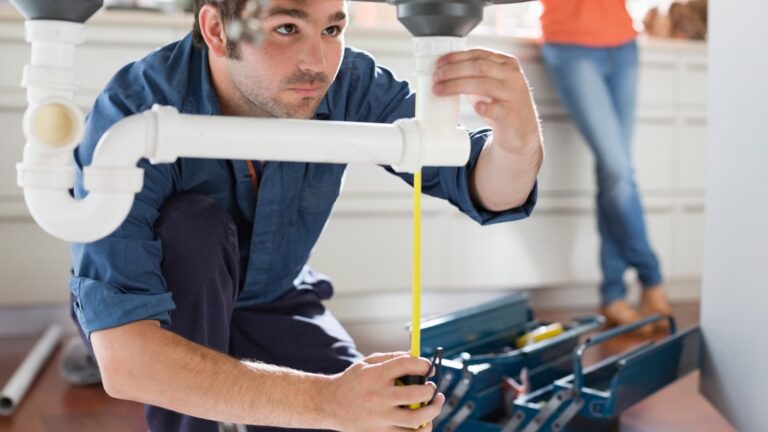Geoffrey Hinton’s message on a recent podcast about artificial intelligence was simple: “Train to be a plumber.”
Hinton, a Nobel Prize-winning computer scientist often called “the Godfather of AI,” said in June what people have now been saying for years: Jobs that include manual labor and expertise are the least vulnerable to modern technology than some other career paths, many of which have generally been considered more respected and more lucrative.
“I think plumbers are less at risk,” Hinton said. “Someone like a legal assistant, a paralegal, they’re not going to be needed for very long.”
Even with the dramatic rise of AI and the evolution of advanced robotics, technologists and tradespeople are touting skilled trades as offering more long-term job security for workers who can do what computers can’t.
Last month, Microsoft revealed a list of jobs that could be endangered as Al advances.
Occupations atop the list were interpreters, historians, customer service and sales representatives, and writers. Some roles considered safe included manual jobs like roofers and rail and dredge operators, hazardous material removal workers and painters. In the health care industry, phlebotomists and nursing assistants were also considered safe.
As AI advances, many manual labor jobs figure to be around for the long haul.
“Automation is a low threat to these jobs because it involves someone manually installing equipment, and many of those who do are getting close to retirement,” said Tony Spagnoli, the director of testing and education for North American Technician Excellence, the country’s largest nonprofit organization for heating, ventilation, air conditioning and refrigeration technicians. “AI can’t replace parts or make improvisational decisions.”
The Bureau of Labor Statistics agrees. It projects that openings for jobs in a variety of trades will grow in the coming years — particularly notable as entry-level job openings for college graduates stagnate.
There is no shortage of hype around AI coming for jobs, and while the U.S. labor market has begun to sputter, hard evidence of AI-related job losses is scant. Even software engineers, seen as at particular risk thanks to AI’s ability to generate computer code, seem relatively unscathed.
But to many, it’s just a matter of time before AI-related job shortages begin to hit hard.
“Innovation related to artificial intelligence (AI) could displace 6-7% of the US workforce if AI is widely adopted,” Goldman Sachs said in a blog post published Wednesday, while also noting that the impact could be “transitory” as people find other jobs.
Whether or not AI does end up taking many jobs, the idea has been enough to push some people to reconsider their futures. The online platform Resume Builder last month released a survey of more than 1,400 Generation Z adults to understand how economic pressures, rising education costs and concerns about AI were shaping their career paths.
Among the key findings were that 42% of those polled, many of them college graduates, were already working in or pursuing a blue-collar or skilled trade job. Their top motivations included avoiding student debt and reducing the risk of being replaced by AI.
For Gen Zers without a degree, blue-collar work offered a path to financial stability without the burden of student loans; and Gen Z men, regardless of education level, were more likely than women to choose blue-collar careers.
“More Gen Z college graduates are turning to trade careers and for good reason,” Resume Builder’s chief career adviser, Stacie Haller, wrote in the survey. “Many are concerned about AI replacing traditional white-collar roles, while trade jobs offer hands-on work that’s difficult to automate. Additionally, many grads find their degrees don’t lead to careers in their field, prompting them to explore more practical, in-demand alternatives.”
But AI could be coming for these jobs, too. Advances in mechanical automation — from humanoid machines to task-specific robots — combined with AI are making up ground on humans.
“Robotics is really coming up,” said Andrew Reece, chief AI scientist at BetterUP, an online platform that in part uses AI-powered tools to support professional development. “It’ll start replacing entry level jobs, such as driving trucks and moving equipment, but it may take time to start figuring out the complex work.”
But there’s a big gap between improvements in robotics and a technology that can replace a human in the real world. Most AI is still trained primarily on text data, giving it little if any understanding of the real world. And the robots themselves still have a long way to go.
“It’s a very wide misconception that we are on the verge of having humanoid robots basically replace workers. In my mind, that’s a myth,” said Ken Goldberg, president of the Robot Learning Foundation at the University of California, Berkeley. “Progress is being made at a slow pace.”
And there’s plenty of room for tradespeople to work alongside AI and robotics, leaving the most sensitive and challenging work for the people who have honed their skills for years.
The automotive industry is leaning on new technology to diagnose problems with cars but it doesn’t expect robots to replace mechanics.
“It might eventually help diagnose a problem, but there will always be a need for testing and replacing auto parts,” said Matt Shepanek, vice-president of credential testing programs at the National Institute for Automotive Service Excellence.
“You’re still going to need someone to perform the physical action.”

